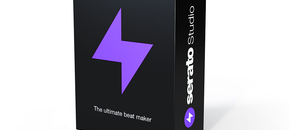There haven't been many big changes in the software sampler world lately. From Ableton Live's Sampler/Simpler to Native Instrument's Maschine, it's not hard to find a solid virtual sample-mangling tool incorporated in the software you already have. Now Serato has made its first foray into the plug-in game with Sample, a sampler that offers an alternative workflow that may be particularly appealing to DJs looking to get into production.
For anyone who has worked with virtual DJ software before, Sample's UI will feel familiar. When you open an instance of the plug-in in your DAW (Sample only runs as a hosted instrument) you first need to drop in a track or file to sample before you get access to its controls. Once that's done, Sample pulls up a zoomable, EQ-coloured waveform viewer that's almost identical to the one found in Serato DJ. You can immediately start playing back the track or scratching through it, but the real fun starts after you've set sample points.
The easiest way to get going is with the Autoset feature. Autoset has four settings—Key Shift Pad, Set Random, Set Slicer and Find Samples. The latter selects 16 cue points (presumably based on prominent transients) and assigns them to two rows of pads at the bottom of the screen. These pads can be triggered from your computer keyboard or via an external controller, but oddly not from within the plug-in itself. You can manually relocate the cue points, lock pads you like by marking them as favourites and repeat the process to see what other samples the software can find. Or you can pick another sample-allocating method, like Random, which does exactly what you would think, or Slicer, which sets 16 evenly-distributed cue points for standard loop chopping. You can also refresh your cue points without affecting sequencer playback, a feature reminiscent of the Elektron Octatrack's Slice Locks function.
Each pad has its own controls for playback level, filter cutoff, attack/release, key shift, time stretch and the option to play in reverse. Right away, this opens up interesting automation possibilities within the plug-in itself. The ability to give each trigger a different amplitude envelope is especially nice and not too common among slice-based samplers. Hitting Select All puts these controls in global mode, so you can manipulate the filter across all cue points or re-pitch your whole sequence. During playback, attempting to edit each sample's effect controls can become a bit chaotic, as the settings change rapidly as your cue points flash by. However, a handy yet unconventionally designed Edit button pauses the control section on either the last-played or last-selected sample so you can focus on adjusting one sound at a time. In Edit mode, you can also fine-tune each sample's start and end points or relocate them entirely.
In terms of global settings, you can toggle playback mode between trigger and gate. It would be nice if this setting could also be accessed per pad, but a similar effect can be achieved by activating and manipulating the attack/release envelopes. You can also switch between mono- and polyphonic playback, repitch the entire track and change BPM sync settings. The lettering of the trigger pads suggests that Serato Sample was designed with laptop musicians in mind, especially those making quick sketches and edits on the go without access to a keyboard or pad controller (where letters like Y, H, U, S, W are largely meaningless).
That being said, the DJ software-like workflow can be really inspiring and just plain fun in the context of so many indistinguishable sampler plug-ins. As a bonus, you can create a few instances of Sample and turn your DAW into a customised and effect-loaded virtual DJing tool. This is perhaps an unintended secondary purpose for the plug-in but it certainly makes the $99 price tag seem more reasonable. With Sample, you can go as deep as you want to. As a plug-in, it's pretty simple. But with so many feature-bloated VSTs around, it can be refreshing to see how much you can do with what is effectively a beefed-up version of virtual DJ cueing.
Ratings
- Cost: 3.8
- Versatility: 3.8
- Ease of use: 4.8
Read the full review at Resident Advisor.



